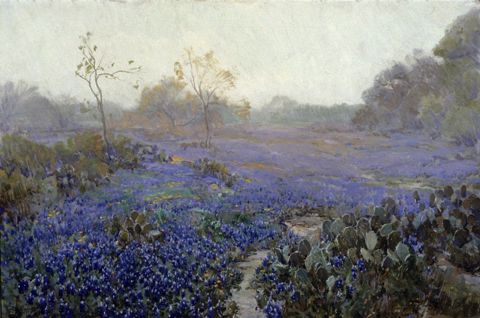The Museum of Fine Arts, Houston, Highlights Early Texas History This October

Julian Onderdonk, Blue Bonnets and Cactus in the Rain, San Antonio, Texas, 1914, oil on panel, William J. Hill Collection.
Julian Onderdonk, Afternoon, Southwest Texas, 1912, oil on canvas, Bobbie and John Nau Collection.
Houston, Texas—September 6, 2016—In October, the Museum of Fine Arts, Houston, opens two exhibitions that bring early Texas history to light: Julian Onderdonk and the Texan Landscape and A Texas Legacy: Selections from the William J. Hill Collection, running concurrently from October 2, 2016, to January 2, 2017. Julian Onderdonk and the Texan Landscape features more than 25 of the American Impressionist’s signature paintings, from luminous views of the Long Island landscape to sweeping impressions of the iconic Texas bluebonnet. The related exhibition, A Texas Legacy: Selections from the William J. Hill Collection, tells the story of early Texas decorative arts through more than 65 works—including furniture, drawings, paintings, pottery, and silver—produced between the mid-19th and early 20th centuries.
“We are thrilled to simultaneously present these two exhibitions, which illuminate Texas’s contributions to the history of American decorative arts and painting,” said Gary Tinterow, director of the MFAH. “Both presentations underscore William J. Hill’s passionate commitment to documenting and sharing the work of 19th-century Texas artists and artisans.”
The Texan Landscape
Julian Onderdonk and the Texan Landscape features more than 25 landscape paintings by American Impressionist Julian Onderdonk (1882–1922), who is best known for his depictions of the sprawling Texas countryside. “Onderdonk’s undeniable passion for the land is evident in his iconic landscapes,” commented Kaylin Weber, assistant curator of American painting and sculpture and organizing curator of the exhibition. “Viewers to the exhibition will have the opportunity to discover Onderdonk’s unique interpretations of the beauty of Texas.”
A San Antonio native, Onderdonk spent his formative years in the early 20th century training in New York under William Merritt Chase. Studying at Chase’s Shinnecock School of Art on Long Island, Onderdonk established his foundations in Impressionist painting and ignited his love of working en plein air. Returning to Texas in 1909, Onderdonk began portraying the distinctive surroundings of his state in his signature depictions of bluebonnets, captured at different times of day and in all seasons.
Julian Onderdonk and the Texan Landscape celebrates the publication of the first catalogue raisonné of the artist, in October 2016. Julian Onderdonk: A Catalogue Raisonné, the culmination of two decades of research by Harry Halff and Elizabeth Halff, documents more than 1,200 of the artist’s paintings, including the works on view in the exhibition.
A Texas Legacy
A Texas Legacy: Selections from the William J. Hill Collection brings together objects from the era of the Republic of Texas (1836–45), when Texas was a sparsely settled territory, to the turn of the 20th century, when the oil boom resulted in the rapid expansion of the state’s economy and population. The exhibition showcases the traditional craft practices employed by early settlers as they produced everything from utilitarian, stoneware pottery to highly accomplished, decorative pieces of furniture. More than 65 works of art will be on view, including furniture, drawings, paintings, pottery, silver, and other goods, created for both personal and commercial use. Highlights include a one-of-a-kind, intricately carved desk by Adolph Kempen; a monumental wardrobe by Johann Michael Jahn; and early Texas silver by Samuel Bell.
“By the late 1800s, transportation networks had vastly improved, making factory-made products widely available in formerly remote areas throughout Texas,” commented Bradley Brooks, curator of the Museum’s Bayou Bend Collection and organizing curator of the exhibition. “A Texas Legacy offers insight into the practices and operation of these early Texan artists and artisans, as they attempted to adapt to the shifting economic dynamics of the time.”
Organization and Funding
These exhibitions are organized by the Museum of Fine Arts, Houston.
Generous support of these exhibitions is provided by Mr. William J. Hill.
About the Museum of Fine Arts, Houston
Established in 1900, the Museum of Fine Arts, Houston, is among the 10 largest art museums in the United States, with an encyclopedic collection of more than 65,000 works dating from antiquity to the present. The main campus comprises the Audrey Jones Beck Building, designed by Rafael Moneo and opened in 2000; the Caroline Wiess Law Building, originally designed by William Ward Watkin, with extensions by Ludwig Mies van der Rohe completed in 1958 and 1974; and the Lillie and Hugh Roy Cullen Sculpture Garden, designed by Isamu Noguchi and opened in 1986. Additional spaces include a repertory cinema, two libraries, public archives, and facilities for conservation and storage. Nearby, two house museums—Bayou Bend Collection and Gardens, and Rienzi—present American and European decorative arts. The MFAH is also home to the Glassell School of Art and its acclaimed Core Residency Program and Junior and Studio Schools; and the International Center for the Arts of the Americas (ICAA), a leading research institute for 20th-century Latin American and Latino art.
1001 Bissonnet, Houston, Texas 77005 | www.mfah.org | 713.639.7300
Media Contact
Laine Lieberman, publicist
713.639.7516 / llieberman@mfah.org
